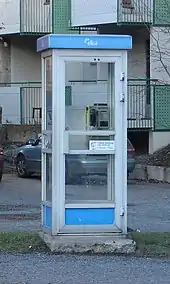Telephone booth
A telephone booth, telephone kiosk, telephone call box, telephone box or public call box[1][2] is a tiny structure furnished with a payphone and designed for a telephone user's convenience; usually the user steps into the booth and closes the booth door while using the payphone inside.
.jpg.webp)
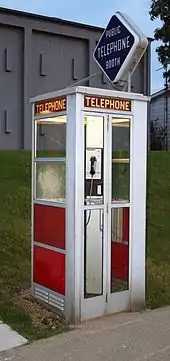
In the United States and Canada, "telephone booth" (or "phone booth") is the commonly used term for the structure, while in the Commonwealth of Nations (particularly the United Kingdom and Australia), it is a "phone box".[3]
Such a booth usually has lighting, a door to provide privacy, and windows to let others know if the booth is in use. The booth may be furnished with a printed directory of local telephone numbers, and a booth in a formal setting, such as a hotel, may be furnished with paper and pen and even a seat. An outdoor booth may be made of metal and plastic to withstand the elements and heavy use, while an indoor booth (once known as a silence cabinet) may have more elaborate architecture and furnishings.[4] Most outdoor booths feature the name and logo of the telephone service provider.
History
.jpg.webp)

The world's first telephone box called "Fernsprechkiosk", was opened on 12 January 1881 at Potsdamer Platz, Berlin.[5] To use it, one had to buy paper tickets called Telefonbillet which allowed for a few minutes of talking time. In 1899, it was replaced by a coin-operated telephone.
William Gray is credited with inventing the coin payphone in the United States in 1889, and George A. Long was its developer.[6] The first telephone booth in London, England, was probably installed near the Staple Inn in High Holborn in May 1903.
In the UK, the creation of a national network of telephone boxes commenced in 1920 starting with the K1 which was made of concrete; however, the city of Kingston upon Hull is noted for having its individual phone service, Kingston Communications, with cream coloured phone boxes, as opposed to classic royal red in the rest of Britain. Also, The Post Office was forced into allowing a less strident grey with red glazing bars scheme for areas of natural and architectural beauty. Ironically, some of these areas that have preserved their telephone boxes have now painted them red.
Design
Starting in the 1970s, pay telephones were less and less commonly placed in booths in the United States. In many cities where they were once common, telephone booths have now been almost completely replaced by non-enclosed pay phones. In the United States, this replacement was caused, at least in part, by an attempt to make the pay telephones more accessible to disabled people. However, in the United Kingdom, telephones remained in booths more often than the non-enclosed setup. Although still fairly common, the number of phone boxes has declined sharply in Britain since the late 1990s due to the boom of mobile phones.
Many locations that provide pay-phones mount the phones on kiosks rather than in booths—this relative lack of privacy and comfort discourages lengthy calls in high-demand areas such as airports.
Special equipment installed in some telephone booths allows a caller to use a computer, a portable fax machine, or a telecommunications device for the deaf.
Privacy
Phone booths have been subject to wireless surveillance by law enforcement. For example, the landmark U.S. Supreme Court case of Katz v. United States involved the Constitutional question of whether the Federal Bureau of Investigation (FBI) could install a listening device outside of the booth.[7]
Recent developments
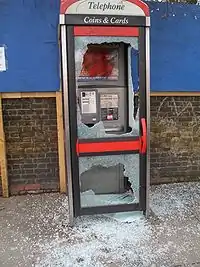

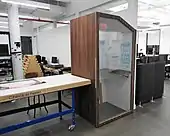
Wireless services
The increasing use of mobile phones has led to a decreased demand for pay telephones, but the increasing use of laptops is leading to a new kind of service. In 2003, service provider Verizon announced that they would begin offering wireless computer connectivity in the vicinity of their phone booths in Manhattan. As of 2006, the Verizon wifi telephone booth service was discontinued in favor of the more expensive Verizon Wireless' EVDO system.[8]
This allows a computer user to connect with remote computer services by means of a short-range device stationed within the booth. The caller pays for usage by means of a pre-arranged account code stored inside the caller's computer. Wireless access is motivating telephone companies to place wireless stations at locations that have traditionally hosted telephone booths, but stations are also appearing in new kinds of locations such as libraries, cafés, and trains. Phone booths have been slowly disappearing since the advent of the mobile phone in 1973.
Vandalism
A rise in vandalism has prompted several companies to manufacture simpler booths with extremely durable pay phones.
Withdrawal of services
Pay phones may still be used by mobile/cellular phone users if their phones become unusable, get stolen, or for other emergency uses. These uses may make the complete disappearance of pay phones in the near future less likely.
Australia
Under the Universal Service Obligation (USO), the Government legally requires telco Telstra to ensure standard phone services and payphones are “reasonably accessible to all people in Australia". Some communities, particularly in remote regional areas, rely on payphones, as well as people who do not have access to a mobile phone.
At their peak in the early 1990s, there were more than 80,000 public phone boxes across the country. By June 30, 2016, according to the ACMA there were about 24,000 payphones across Australia. On 3 August 2021, with 15,000 public phones remaining across Australia, Telstra announced that all calls to fixed line and mobile phones within Australia from public phones would become free of charge, and that Telstra had no plans to further eliminate public phones.[9]
Belgium
In Belgium, majority state-owned telco Belgacom took the last remaining phone booths out of service on 1 June 2015.[10]
Denmark
On 13 December 2017 the last three public telephone booths in Denmark had their telephones removed.[13] They were situated in the town of Aarhus.
Finland
By 2007, Finnet companies and TeliaSonera Finland had discontinued their public telephones, and the last remaining operator Elisa Oyj did that during the beginning of that year.[14]
France
According to Orange CEO, Stéphane Richard, there are only 26 public phone booths[15] still operating in France as of 2021. The "Macron law" of 2015 ended Orange mandatory maintenance of a public phone booth network, its decline in use being caused by the cell phones era. These are, by law, maintained in rural area where there is no cell phone service. Consequently, they are removed once the area is properly covered by at least one mobile phone operator.
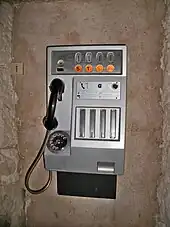
Ireland
Eir, the Universal Service Obligation carrier with regard to payphones, has been systematically removing payphones which fall under the minimum requirement for retention, of a rolling average of one minute of usage a day over six months [16]
As of June 2019, 456 locations retain payphones (with none in the entirety of County Leitrim); down from 1320 in March 2014.[17]
Jordan
In 2004, Jordan became the first country in the world not to have telephone booths generally available. The mobile/cellular phone penetration in that country is so high that telephone booths have hardly been used at all for years. The two private payphone service companies, namely ALO and JPP, closed down, and currently there's no payphone service to speak of.[18]
Norway
The last functioning phone box in Norway was taken out of service in June 2016. However, 100 phone boxes have been preserved around the country and are protected under cultural heritage laws.[19]
Sweden
The first telephone booth in Sweden was erected in 1890. In 1981 there were 44,000 of them,[20] but in 2013, there were only 1,200, with a withdrawal of the last one in 2015.[21] A survey showed that in 2013, only 1% of the population in Sweden used one the previous year.[21]
United Kingdom
The red telephone kiosk is recognised as a British icon and the BT Group still hold intellectual property rights in the designs of many of the telephone boxes, including registered trade mark rights. [22] BT is steadily removing public telephone kiosks from the streets of the UK. It is permitted to remove a kiosk without consultation provided that there is another kiosk within 400 m (1,300 ft) walking distance. In other cases, it is required to comply with Ofcom rules in consultation with the local authority.[23] Some decommissioned red telephone boxes have been converted for other uses with the permission of BT Group, such as housing small community libraries or automated external defibrillators.[24][25]
United States
In 1999, there were approximately 2 million phone booths in the United States. Only 5% of those remained in service by 2018. About a fifth of America's 100,000 remaining pay phones are in New York, according to the FCC. However, only 4 phone booths remain in New York City, all on Manhattan's Upper West Side; the rest have been converted into WiFi hotspots. Incoming calls are no longer available, and outgoing calls are now free. In February 2020, the city confirmed that despite a plan to remove dozens of pay phones, the iconic booths would continue to be maintained.[26][27]
Smoking ban
Following the commencement of the smoking ban in England in 2007, it became illegal to smoke in red telephone boxes (types K2 to K8), due to these boxes being completely enclosed spaces. The smoking ban requires owners to display no smoking signs, which has resulted in BT displaying a "no smoking" sticker which refer to the telephone box as "premises". Despite smoking in red telephone boxes being banned, smoking in other telephone boxes remains legal as these boxes are not completely enclosed spaces.
Advertising
Many telephone boxes in the United Kingdom have become locations for advertisements, bearing posters, with the development of "StreetTalk" by JCDecaux.[28] This is in addition to the ST6 public telephone introduced in 2007 which is designed to feature a phone on one side and a JCDecaux-owned advertising space on the otherside. The advertising pays for the running of the phone.
In 2018, the UK Local Government Association drew attention to "Trojan" telephone boxes. These are telephone boxes whose main purpose is advertising. A loophole in planning law allows these to be erected without planning permission and the LGA is seeking to close this loophole.[29]
Replacements for telephone booths
In the final third of the 20th century, pay telephone mounted on walls or kiosks became more common, often replacing older telephone booths.
 Partially enclosed pay phone in North Carolina, typical of many early replacements for telephone booths in the United States, continuing an enclosed space on three sides without the booth.
Partially enclosed pay phone in North Carolina, typical of many early replacements for telephone booths in the United States, continuing an enclosed space on three sides without the booth..JPG.webp) Public telephones in Kashmar, Iran; such structures replaced earlier booth enclosed telephones late in the 20th century
Public telephones in Kashmar, Iran; such structures replaced earlier booth enclosed telephones late in the 20th century Pay telephone with internet access in Münster, Germany. March 2014, still using the old booth format but without a door.
Pay telephone with internet access in Münster, Germany. March 2014, still using the old booth format but without a door. An example of a person using a Telstra phone box in Victoria, Australia; used after telephone booths were phased out.
An example of a person using a Telstra phone box in Victoria, Australia; used after telephone booths were phased out._.jpg.webp)
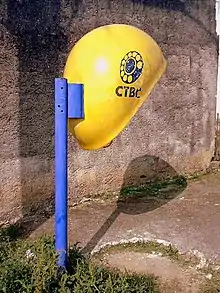 Telephone kiosk in Brazil, popularly called orelhão ("big ear") because of its shape
Telephone kiosk in Brazil, popularly called orelhão ("big ear") because of its shape Payphones mounted on a subway wall, South Korea.
Payphones mounted on a subway wall, South Korea. A decommissioned telephone booth in Ilford, London, 2022
A decommissioned telephone booth in Ilford, London, 2022 A decommissioned telephone booth in Berlin, 2022
A decommissioned telephone booth in Berlin, 2022
In popular culture
- In comic books published by DC Comics, the telephone booth is occasionally the place where reporter Clark Kent discards his street clothing and transforms into the costumed superhero Superman. Some films and television series featuring the character have also used, referenced, or spoofed this plot device.[30]
- The BBC science-fiction television series Doctor Who features the TARDIS, a time machine disguised as a Mackenzie Trench-style police box (a phone booth used by police).
- La cabina is a 1972 Spanish short film about a man trapped in a phone booth. Nobody is able to free him, and the whole booth — with the man still inside — is carted away to a warehouse.
- The 1986 comedy film Clockwise features John Cleese's character vandalising a phone in a booth in frustration after it malfunctions.[31] The scene played on the public perception in Britain at the time that telephone booths were frequently out of order.[32]
- Phone Booth is a 2002 thriller film where a man in a phone booth is targeted by a sniper.
- The Bill and Ted films from 1989 (Bill & Ted's Excellent Adventure), 1991 (Bill & Ted's Bogus Journey), and 2020 (Bill & Ted Face the Music) set in San Dimas, CA used a phone booth as a means of time travel and transport of historical figures.
- In Harry Potter and the Order of the Phoenix, Harry and Mr. Weasley enter a London phone booth and dial 62442 (MAGIC). The booth is an elevator used as the visitor's entrance to the Ministry of Magic.
- In the opening credits to the 1960s T.V. satire comedy Get Smart, Maxwell Smart (played by comedian Don Adams), a Bond-like secret agent a.k.a. Agent 86, would go through a corridor, armed with steel doors which would close after his passage, to a phone booth in which he would enter, close its door, dial a special number on the rotary dial and, after hanging up, would get lowered into CONTROL's secret offices.
See also
- Callbox
- Hotspot (Wi-Fi)
- Interactive kiosk
- KX telephone boxes
- Mojave phone booth
- Payphone
- Police box
- Red telephone box
- Giles Gilbert Scott, the English architect who designed the iconic red telephone box
- Phonebooth stuffing
 Telephones portal
Telephones portal
References
- "Phone Boxes". legendarydartmoor.co.uk. 21 March 2016. Archived from the original on 13 February 2021. Retrieved 22 September 2012.
- Discussion Note on Phone Boxes, Kiosks and ATM machines at Urban Design London
- Sag, Ivan; Baldwin, Timothy; Bond, Francis; Copestake, Ann; Flickinger, Dan. "Multiword Expressions: A Pain in the Neck for NLP" (PDF). Stanford University. p. 2. Archived from the original (PDF) on 13 January 2012. Retrieved 1 June 2012.
- "Public Telephones". Melchior Telematics. Archived from the original on 3 March 2016. Retrieved 4 December 2007.
- "Das war 1881 - Ereignisse 1881" (in German). was-war-wann.de.
- "Site of World's First Pay Phone". ctmuseumquest.com. Retrieved 11 October 2017.
- Agur, Colin (2013). "Negotiated Order: The Fourth Amendment, Telephone Surveillance, and Social Interactions, 1878-1968". Information & Culture. 48 (4): 419–447.
- Jen Chung (2 May 2005). "Goodbye Free Verizon WiFi". Gothamist LLC. Archived from the original on 27 May 2007. Retrieved 4 December 2007.
- "Local, national and calls to mobiles will now be free from Telstra payphones". Australian Broadcasting Corporation. 3 August 2021. Retrieved 3 August 2021.
- Belgacom hangs up on Belgium's last phone booths, eurocomms.com; accessed 11 October 2017.
- "Last Czech phone booth to be removed". 17 June 2021.
- "V Čechách končí éra telefonních budek. Nadace O2 jako jejich poslední připomínku spouští charitativní aukci".
- David Rue Honoré (20 December 2017). "Danmarks sidste mønttelefon er taget ned". Berlingske Tidende (in Danish). Retrieved 20 December 2017.
- "Elisa luopuu yleisöpuhelinliiketoiminnasta syksyllä 2007" (in Finnish). Elisa Oyj. 15 November 2006. Retrieved 4 December 2007.
- "Il ne resterait plus que 26 cabines téléphoniques en France" (in French). Elisa Oyj. 2021-04-23. Retrieved 2022-03-06.
- "Ever wonder why there are still payphones around Ireland? Here's why". independent. 3 August 2016.
- Online, eir. "Advertise with us • eir ie". www.eir.ie.
- "Payphones suffer from cellphone growth 2004". CellularOnline. 22 March 2004.
- HJERTHOLM, TOM R. (Feb 1, 2018). "– En ny tid venter kioskene". Bergensavisen.
- Sällsynt telefonkiosk överlever (Swedish)
- Telefonkiosken tackar för sig Archived 4 October 2013 at the Wayback Machine
- "BBC - Press Office - The Great British Design Quest". www.bbc.co.uk.
- "Guidance on procedures for the removal of public call boxes" (PDF). stakeholders.ofcom.org.uk. March 14, 2006. Retrieved May 22, 2021.
- Professor Wu (2018-11-03). "British phone box libraries". Nothing in the Rulebook. Retrieved 2021-03-30.
- "CONVERT A PHONE BOX | Community Heartbeat Trust". www.communityheartbeat.org.uk. Retrieved 2021-03-30.
- "Upper West Side is home to city's last remaining phone booths". NY1. 26 February 2018. Retrieved 1 March 2020.
- Carlson, Jen (28 February 2020). "Most Of The Last Remaining Pay Phones In NYC Will Be Ripped Out". Gothamist. Retrieved 1 March 2020.
- "StreetTalk". JCDecaux. Retrieved 30 January 2018.
- "LGA: call for crackdown on 'trojan' telephone boxes amid 900 per cent rise in some areas". Local Government Association. Retrieved 30 January 2018.
- Younis, Steve. "Superman and the Phone Booth". SupermanHomepage.com. Retrieved 11 July 2013.
- "Clockwise". Film News. Retrieved 11 November 2022.
- Lewin, David (25 October 1987). "Python's Cleese stars are a salesman for "Wanda"". Los Angeles Times. p. 27.
External links
- PayPhoneBox Index of payphone numbers and photographs of payphones in unusual or famous places around the world.
